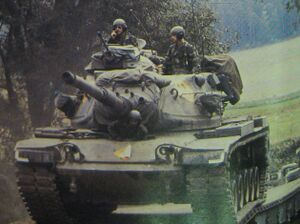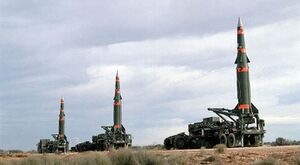Third Axiom War: Difference between revisions
No edit summary |
No edit summary |
||
| Line 27: | Line 27: | ||
| status = | | status = | ||
| combatant1 = {{plainlist | | | combatant1 = {{plainlist | | ||
{{flag|South Axiom}} | |||
---- | ---- | ||
'''Multi-national Force''' | '''Multi-national Force''' | ||
Revision as of 06:06, 2 April 2019
This article is incomplete because it is pending further input from participants, or it is a work-in-progress by one author. Please comment on this article's talk page to share your input, comments and questions. Note: To contribute to this article, you may need to seek help from the author(s) of this page. |
The Third Axiom War was a ten month-long conflict from May to August 1984 between the Federation of South Axiom and the People's Republic of Axiom. It was the last full-scale conflict to occur between major powers, and the second conflict in world history where nuclear weapons were used in anger.
The war began with a surprise offensive against the South Axiomian border provinces of Wralod, Istalar, North Skale, Sovyl and Balagur by the People's Army of Axiom. South Axiom ordered a general mobilization of all available reserves, and an emergency meeting of NATO leaders and commanders invoked Article 5 of the NATO treaty against the People's Republic of Axiom. Despite mainly being a conflict between South Axiom and the PRX, the Third Axiom war also saw extensive direct and indirect support for both countries from NATO and Warsaw Pact nations.
After months of heavy conventional warfare, including the Fall of Kesra, the Battle of Solkar Ridge, the Liberation of Ralis and the Fondor Landings, the PRX forces were pushed back to Lazar, Draxis, South Marat and Qaldur. The air, naval and technological superiority enjoyed by South Axiom and its NATO allies proved vital in turning the tide. The Battle of Kasgar Plains in April 1982 resulted in the encirclement and destruction of an entire PRX armored corps, and was the final large battle of the war, However, the PRX resorted to tactical nuclear weapons to stop the advancing RXA and RXMC divisions, leading to a limited South Axiomian nuclear strike against PRX military installations.
| Third Axiom War | |||||||
|---|---|---|---|---|---|---|---|
| Part of Cold War | |||||||
Advancing South Axiom TX-1 Sabre-cat Tank near Ralis, Istalar | |||||||
| |||||||
| Belligerents | |||||||
Multi-national Force
Support
|
| ||||||
| Strength | |||||||
|
South Axiom
Multi-national Force
|
People's Republic of Axiom
Warsaw Pact
| ||||||
| Casualties and losses | |||||||
|
South Axiom
Multi-national Force
|
People's Republic of Axiom
Warsaw Pact
| ||||||
Lead up to War
Since the Second Axiom War thirty years earlier, relations between the Federation of South Axiom and the People's Republic of Axiom had always remained hostile. This was exacerbated by the PRX's development of nuclear weapons in 1970, and the wider Cold War in Europe and the world. Border incidents, military exercises and airspace incursions were common during the 1960s and 1970s. Even during the detente era of the 1970s, the Axiom subcontinent still maintained heightened military readiness. Throughout these three decades an arms race between the two powers had led to the deployment of countless new weapons systems, from tanks and artillery to aircraft and warships.
The start of the 1980s saw the end of detente between the United States and the Soviet Union. The elections of conservatives such as Reagan in the US and Thatcher in the UK signaled a return to the East-West rivalry. The Soviet invasion of Afghanistan and the Intermediate Nuclear Forces issue were just two of a growing list of clashes between the capitalist and communist camps. The Able Archer crisis, the shooting down of KAL 007 and the Soviet nuclear false alarm of 1983 all placed the two sides dangerously close to conflict.
The People's Republic of Axiom had concerns that its numerical superiority in air and land forces was being steadily neutralized by the technological, economic and naval edge of the Federation of South Axiom. In particular the road-mobile, 1,840 km range MXM-3 Viking MRBM, deployed in 1982, had the potential to carry out a highly accurate first strike on PRX nuclear and strategic assets.
From February 1984 the PRX Security Bureau (the XSB) started to closely monitor South Axiom forces and government agencies, looking for signs of an impending attack. In early May 1984, South Axiom conducted a civil evacuation drill, closely followed by a military readiness drill. The increased activity on official South Axiom channels and around military bases convinced the PRX leadership that a strike was imminent, and more than 1.7 million PRX troops were secretly readied for a preemptive assault.
The PRX Invasion
At 4:30 AM on May 17, 1984, the PRX Air Force launched a massive conventional air and missile strike on South Axiomian air bases. Meanwhile more than 20,000 paratroopers and special forces troops landed behind RXA lines, aiming to capture important transport links and military positions. They opened up paths for the main armored and mechanized divisions, with heavy concentrations of firepower driving back the RXA forces.
At sea, PRX nuclear and conventional attack submarines attacked RXN ships, sinking a destroyer, two frigates, several corvettes and numerous civilian cargo ships. PRX Naval Aviation bombers attacked the RXMS Golas carrier battle group with supersonic anti-ship missiles, damaging two escorts and the Golas. However, RXN air defenses and carrier air patrols managed to shoot down 8 out of the 14 attacking bombers. The PRX submarine forces also lost two diesel submarines against RXN ASW screens.
In the air and land battles, PRX divisions and air wings used the element of surprise to encircle RXA troops and destroy dozens of aircraft on the ground. In two weeks PRX armored spearheads penetrated up to 200 km into South Axiomian territory, but many RXA units and civilians manage to escape to friendly lines.
South Axiom and NATO Response
On the evening of May 17, the South Axiomian Parliament met in a hardened bunker at RXAF Jurat to formally declare war on the People's Republic of Axiom. Most members were meeting via secure military communication links as they had been dispersed to various facilities nationwide. Prime minister William Taylor then addressed the nation, followed by His Majesty Richard III the next day.
During the confusion of the early battles, South Axiomian forces retreated and regrouped while trying to evacuate civilians from front-line areas. The reserve forces were mobilized and civil defense plans were implemented. The South Axiomian Ministry of Defense considered using tactical nuclear weapons to stop the advance but decided to wait for signs of a PRX WMD strike.
The North Atlantic Treaty Organisation quickly responded to the invasion, with Article 5 being invoked on May 20. A coalition of Western nations led by the United States and United Kingdom pledged military and non-military assistance to the Royal Axiomian Armed Forces. Given the proximity of the Axiom subcontinent to NATO's Western European and North Atlantic flank, NATO commanders were worried that the war could spread and escalate into a general conflict with the Warsaw Pact across much of Europe. Thus, the deployment of the Multi-national Force to South Axiom was accompanied by diplomatic efforts to keep Soviet involvement to a minimum.
The Soviet Politburo and military commanders had also been surprised by the invasion. While they had received some advance notice of the plans, this had not been enough to properly coordinate a response to the rapidly widening conflict. In official statements the Soviet government announced aid and assistance to its allies in Kralas, but also sought to delay the West through diplomacy until Warsaw Pact military forces could be properly deployed and readied.
The rapid PRX advance meant that substantial parts of Istalar, North Skale, Sovyl and Balagur were in PRX hands by the end of May. Despite heavy fighting in and around Kesra, most of the RXA I Corps had to retreat from the city. However, the 3rd Infantry Division and several reserve brigades were encircled by the PRX 19th and 24th Armies by May 29th. The 20,000 troops in the Kesra pocket fought bravely for almost three weeks, but the remaining 8,000 were forced to surrender on June 17th. The Battle of Kesra delayed the PRX advance in the central sector, and bought the RXA Second Army critical time to stabilize the front.
Inital NATO ground deployments to South Axiomian territory included three US Army Divisions and a marine expeditionary brigade along with two Commonwealth brigades from the UK, Canada, Australia and New Zealand. More forces would pour in over the next three months, from both NATO and non-NATO allies. However, the US and Commonwealth provided the most assistance because most NATO ground forces were deployed in Germany to counter a rapidly mobilizing Warsaw Pact. While initial NATO deployments were small in size, they helped man the line against PRX forces and replace recuperating RXA formations.
Stalemate
As the PRX offensive continued, it ran into severe supply issues. The front was now hundreds of kilometers away from PRX supply areas, and logistical columns were often attacked by NATO aircraft or South Axiomian stay-behind irregular warfare units. Their repeated and failed offensives to capture Bryat and Vadyar showed how superior NATO technology and training could overcome PRX numerical superiority.
Newly deployed NATO tanks such as the TX-2 Lion, M-1 Abrams and Challenger 2 showed a clear superiority against the PRX T-62 and T-72 tanks, while the advanced F-15, F-16, F-24 and Tornado gradually regained control of South Axiomian airspace from PRXAF MiG-21, MiG-23 and MiG-25 fighters.

